Rich Snippets: A Reliable Guide for Your SEO Strategy
Did you know that web pages with high CTR can get a boost in search rankings? And getting listed as rich snippets is one of the greatest ways to boost your average click-through rate (CTR).
That’s because, rich snippets listings:
- Are more eye-catching
- Display extra information
- Address search intent with structured data
Rich Snippet Listing
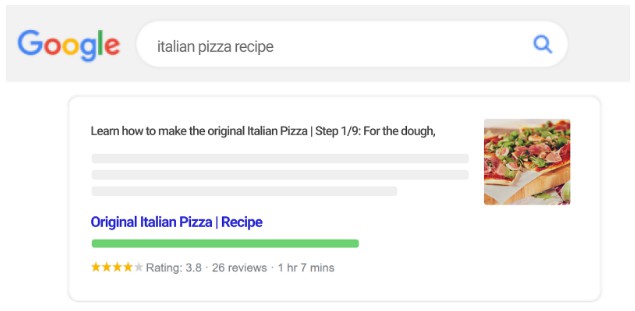
Normal Snippet Listing
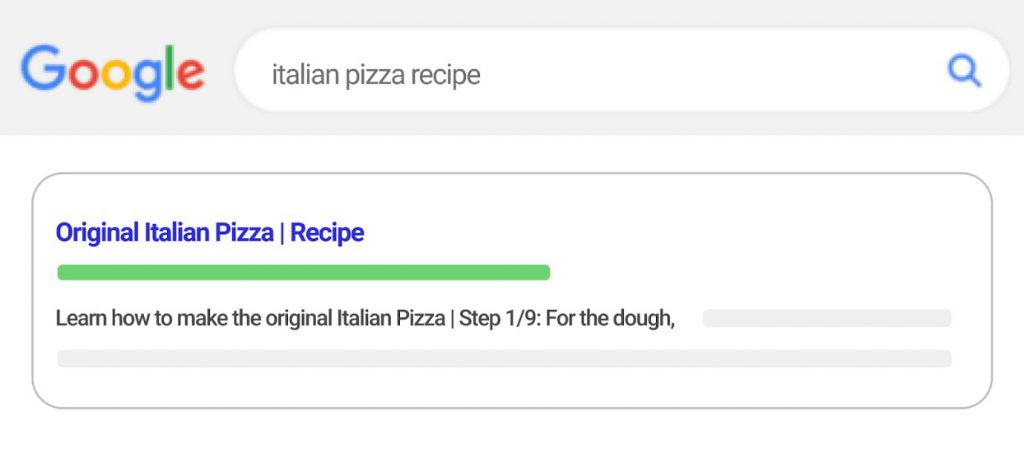
Helping Google understand the context of your page’s data correctly can turn beneficial for your brand’s visibility in the SERPs.
Pretty cool, right?
In this guide, you’ll find out:
- How to help Google understand your data better.
- How to make your website stand out in crowded search results with rich snippets.
- How the enhanced search visibility will lead to more clicks, traffic, leads, and potential customers for your business.
Are you ready?
What is a Rich Snippet?
Rich snippets are search results that are enhanced to provide additional information along with the URL, title, and description of a web page.
Google extracts this information from the structured data added in a web page’s HTML.
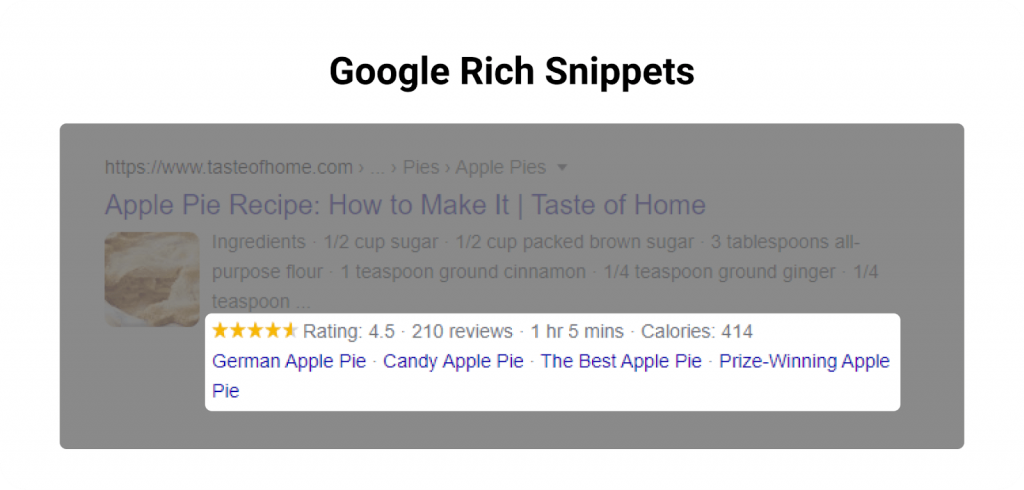
Why Are Rich Snippets Important?
In the introduction, we compared an average listing vs. a rich snippet listing.
Did you see the massive difference?
With features like ratings, time to cook, ingredients, and thumbnail images, rich snippets instantly draw your attention.
And it’s understandable.
After all, they also occupy extra real estate on the SERPs.
Here is a quick comparison of the fields covered in both types of search results listings:
| Average Listing | Rich Snippets |
| Title | Title |
| Description | Description |
| URL | URL |
| Date (not always) | Product Image |
| Product Review | |
| Date Information | |
| Ratings | |
| Price Information | |
| Icon of the Website |
That’s striking, isn’t it?
It isn’t just about displaying additional information though.
Getting featured in rich snippets can give you an SEO edge.
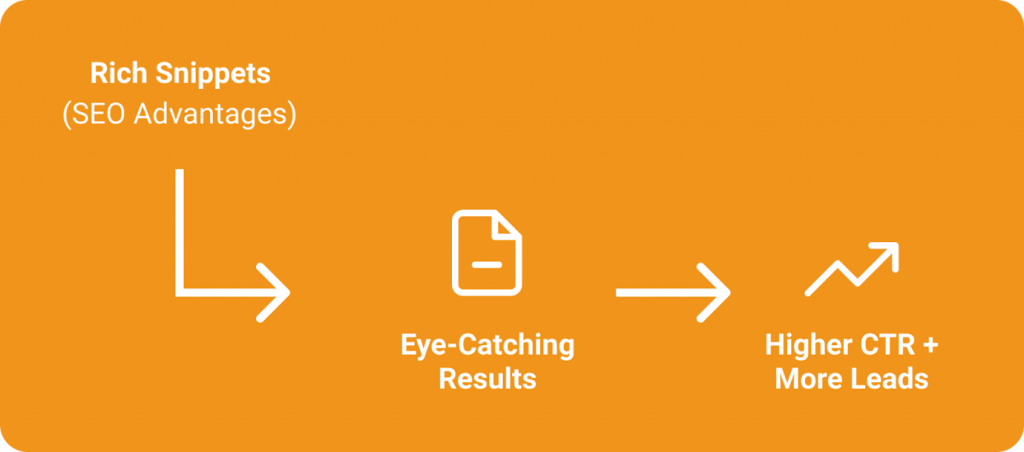
Here are the SEO advantages of getting featured in rich snippets:
- Eye-Catching Results:
Rich snippets include thumbnail images as well as other relevant information. Because of this, rich snippets are more eye-catching than your average SERP results. - A Higher Organic CTR:
We’ve already discussed how rich snippets are more visually attractive, which is why users will more likely click on them.
In a nutshell, getting featured in rich snippets can boost your overall click-through rate and search traffic. - More Qualified Leads:
Rich snippets pick up information that users are likely to search for and display them in the SERPs.
As the result shows insights that address user intent, there is a higher chance that you’ll get more qualified leads through rich snippets.
Now that you know the benefits of rich snippets, it’s time to dive in deeper.
Get the full SEO Checklist and start taking ALL the steps you need to in order to rank at the top of Google.

John Abott The SEO Checklist by SEOBuddy is awesome. It doesn’t just tell you what you need to do, it walks you through the process.
Which Are the Different Types of Rich Snippets?
When it comes to rich snippets, there isn’t a concept like one size fits all.
Depending on the type of website and page you want to feature in the rich snippets, you need to pick the right snippet type.
There are more than a dozen different types of rich snippets out there. In this section, we’ll focus on the seven main types of rich snippets that you can choose from.
Review Snippet
Such rich snippets show a star rating for reviews on a scale of 1-5. It could pick ratings from aggregate user reviews or show the rating by an individual reviewer.

Image via Google
Movie Snippet
You can see details like the release date, filming locations, and rating for a specific movie along with a description. It also displays the rating for a movie on a scale of 1-10.

Image via Google
Recipe Snippet
As the name suggests, these rich snippets are specifically tailored for recipes. You can see details like thumbnail images, cooking time, calorie count, and dish rating for these types of rich snippets.

Image via Google
Event Snippet
These rich snippets provide details like event venue, time, and thumbnail images.
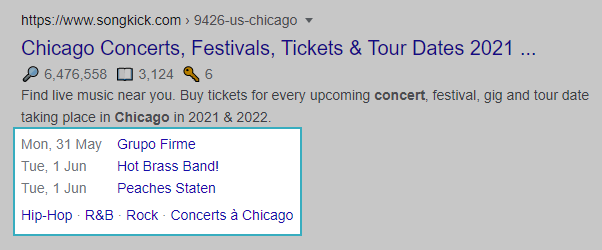
Image via Google
Music Snippet
Music snippets are tailored towards listings that are related to the name of a musician or a music album.
For a listing related to a musician, it shows details like years active, instruments, and other names.
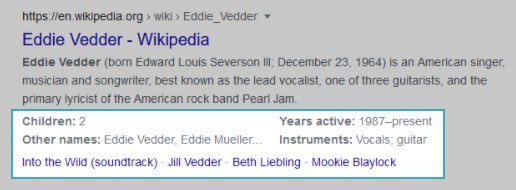
Image via Google
For album-related rich snippets, you can get details like genre, length, producer, studio, and more.
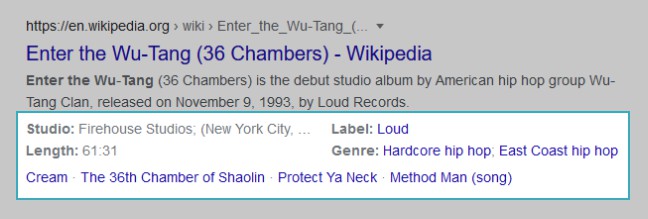
Image via Google
Product Markup Snippet
This rich snippet is great to give users a quick overview of your product. It can include details like rating, price range, and whether or not the product is in stock.

Image via Google
Software App Snippet
This snippet displays app information to highlight what your app offers. It includes rating, price, and platforms on which the app is available. This feature is still in the beta phase.
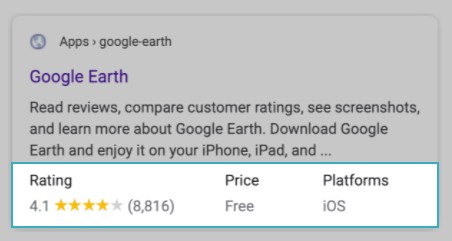
Image via Google
That’s not all…
Explore Other Types of Rich Snippets & Enhanced Search Results
Here are a few other categories of enhanced search results:
- Critic Review
- Image License
- Local Business
- Employer Aggregate Rating
- Fact Check
- Dataset
- Home Activities
- FAQ
- How To
- Estimated Salary
- Q&A
- Job Posting
- Logo
- Math Solvers
- Practice Problems
- Product
- Podcast
- Video
- Subscription & Paywalled Content
- Speakable
Want to learn more about them?
Google has a comprehensive guide that lists all of them along with examples. Check it out here!
How to Add Rich Snippets to Your Website
That brings us to the main question…
How can you add rich snippets?
For this, you need to first understand how rich snippets work. They are featured based on the structured data that you add for certain content pieces.
This data is organized such that Google finds it easy to interpret it correctly and display it in the SERPs in a more enhanced manner.
Typically, Google crawlers may have to look at content that is framed like this:

In the case of rich snippets, you frame it all in a more readable way.
Here is an example:

If you want to add rich snippets, here are some of the best practices you should follow:
Choose the Right Snippet Type
As we’ve already discussed, there are many different types of rich snippets out there. The first step for you is to figure out which category is right for your web page.
Are you publishing a recipe?
Do you want to add content related to an event?
Or, are you adding FAQs?
Invest some time in identifying and analyzing the use cases of different snippet types.
Once you pick the snippet type you want to create, check out the available search enhancements for your chosen category.
You can look for more information about it here.
Study Mandatory Requirements for Your Snippet Type
Each snippet type has some mandatory requirements. Study them so as to ensure you’re on the right track.
Again, Google provides all of the information you may need for this.
Head over to the Search Gallery page to check all of the required item properties for your snippet type. The fields that are shown as mandatory should be included in your code.
For instance, let’s say you are creating a course online and want to include a rich card for that. You’ll need to tag the description and name. Along with it, you can include the course provider as well.
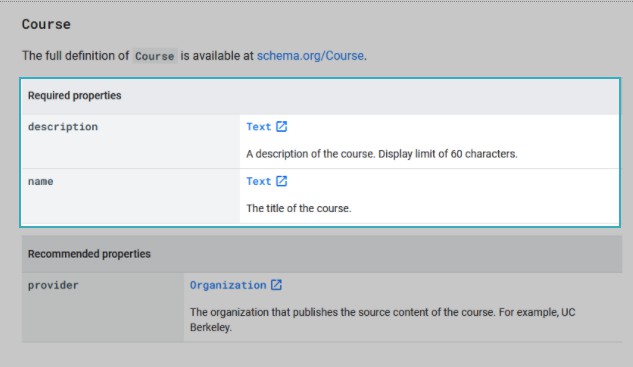
Image via Google
Add Structured Markup Data
The next step is to write the code as needed. While multiple formats are supported, it is recommended that you follow the JSON-LD format.

Google and Bing both accept that format.
To test your code, you can use Google’s Structured Data Markup Helper tool.
Does it seem a bit complicated?
You can check out this free structured data tool to simplify the process. All you need to do is to select the schema type you want to create, fill out the required information, and click on “Generate.”
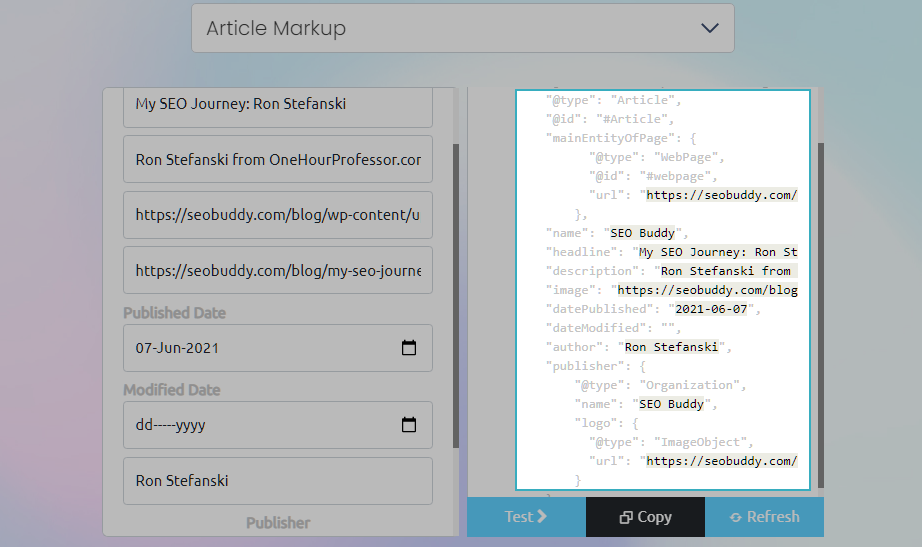
Then, copy-paste the generated JSON-LD code to your web page’s HTML.
Here’s how:
Once you have the code, you need to copy it to the <head> section of your HTML page.
However, you should keep in mind that you will need to add structured data to specific web pages, not to the entire website.
For instance, let’s say you have structured data for recipes.
You’ll need to add this to pages that include recipes. You don’t need to include it on the rest of your blog pages.
Maintain a Consistent Content Structure
There is more to rich snippets than just the technical stuff.
Even when you are writing content, there are a few things, taking care of which, can improve your chances of getting featured in rich snippets.
The way you format your content can play a major role in it.
For starters, don’t write a big block of text at once. Instead, opt for short paragraphs and bullet lists to make your content easily scannable.
For on-page SEO, you should take care of <HTML> tags while writing your content.
| Tags | How to Use Them |
| <h2> and <h3> | Use them for questions that are related to the overall user intent. You should also include keywords in these tags. |
| <ol>, <ul>, and <li> | Use them for all of your list items. |
In addition to adding tags, it is also a good idea to include an FAQ section in your content. Since it addresses commonly asked questions, you’re adding content that people are searching for.
Just make sure you pick the right questions to add to this section.
Whenever you search for a keyword, you always see a section titled, “People Also Ask,” on Google search results pages.
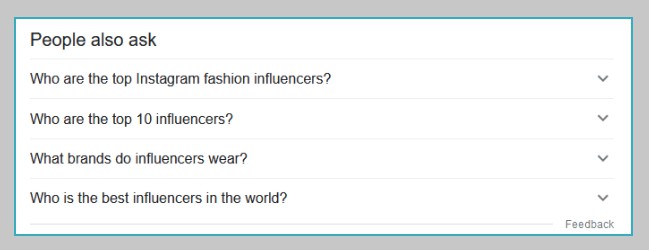
Image via Google
This is your quick shortcut to finding the right FAQs to include in your content. Just make sure you answer those questions concisely in your posts.
You can also check out the predictions that Google shows when you type in a keyword. Another way to go about it is to scroll to the end of the SERP and look at “Related Searches.”
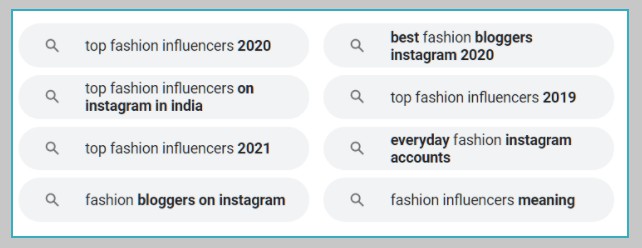
Image via Google
Check Google Search Console for Any Errors
The final step is to check the performance of your rich snippets. Along with it, you will also need to check your code for any errors during implementation.
There are three different ways of checking your errors through the Google Search Console.
Search Appearance Reports
When you go to the Google Search Console, click on the option, “Search Results,” under the Performance tab.
From there, click on “Search Appearance” and go to “Rich Results.”
When you click on “Pages,” you’ll be able to see which web pages show as rich cards in your results. You can also find the total number of impressions, clicks, and other important details.
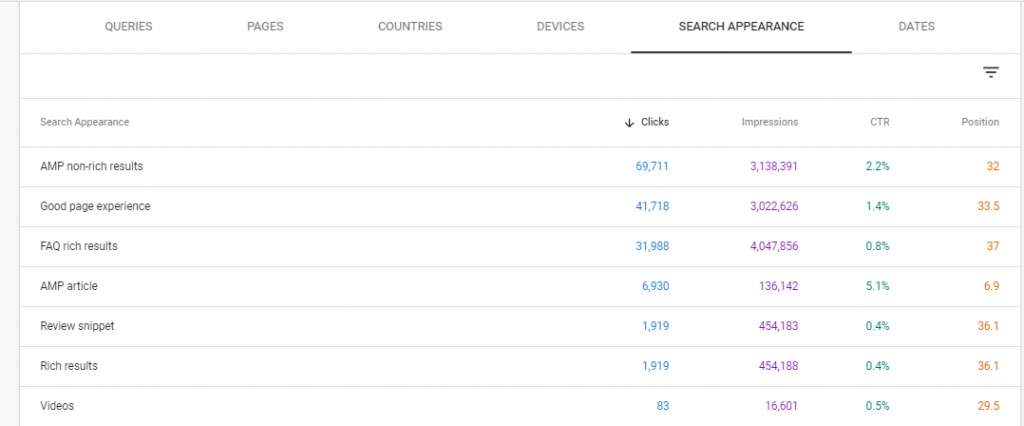
Enhancement Reports
To troubleshoot any errors with structured data, you can also check out the enhancement reports. For this, go to Google Search Console and click on any report under the “Enhancements” tab.
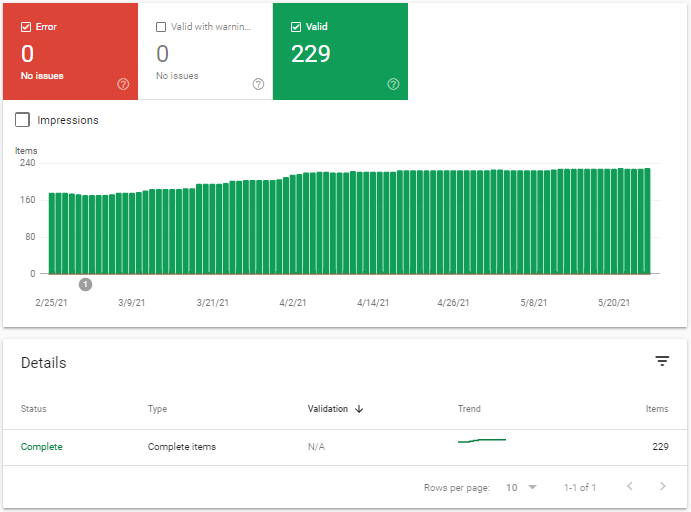
URL Inspection Tool
Another alternative way to test your page for any errors related to structured data is to use the URL Inspection Tool.
You can also test a page for structured data errors using the URL Inspection Tool.

Check how your rich snippet looks in the SERP
If you want to check how your page looks in the SERP, you can use the Google Snippet Tool By Sitechecker.
The main benefit of using this testing tool is that they help you see if your metadata (or even content on your website) is properly formatted when it appears in search results. Just because something looks good to you doesn’t mean it’s good to Google. Ideally, with proper formatting, humans and search engine bots should be able to read your site’s metadata and content without issue.

When Does Google Show Rich Snippets?
You’ve followed all of these steps to add rich snippets.
Wondering when your result will show up there?
The key is to be patient. Like most SEO practices, reaping the benefits of your efforts may take a while.
To improve your chances of showing up in rich snippets, make sure you:
- Create a hierarchical website structure.
- Write scannable content.
- Format your content well.
- Add structured markup data properly.
Use advanced tools like Semrush to keep a tab on your rich snippets. Consistently monitor and optimize your pages for performance.
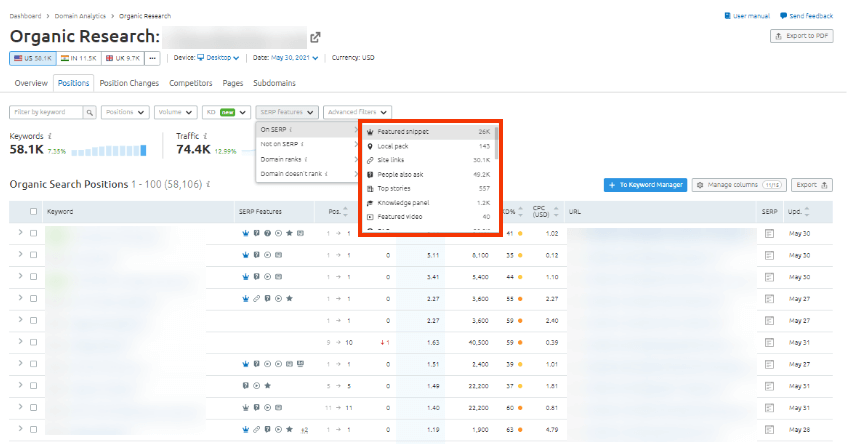
Even after following all of these steps diligently, it’s possible that you may not make it to rich snippets.
What should you do then?
Be patient.
Continue working on your SEO strategy to increase your website authority.
You’ll eventually get there.

Now it’s time to discover the other 102 steps that will get more organic traffic flowing to your website. Get the SEO Checklist here.
Want to get a sneak peek of what it looks like?
Enter your email and get a free demo version of the SEO Checklist.
Conclusion
It’s been a while since Google replaced the plain, old blue snippets in their SERPs with rich snippets.
They’re more visual and provide a lot of additional information to users. That makes it more appealing to the users. If you want to get more clicks and traffic, you should work on adding rich snippets.
To be eligible for rich snippets, you should work on adding structured data to your web pages.
While it may seem complicated, the process is quite simple. Just choose the right snippet type, create JSON-LD code, test your code, add it to your web page’s HTML, and then check it for errors.
Now that you know the process, are you ready to get started?
For more tips related to advanced SEO, take a look at the complete SEO Checklist on our blog.



